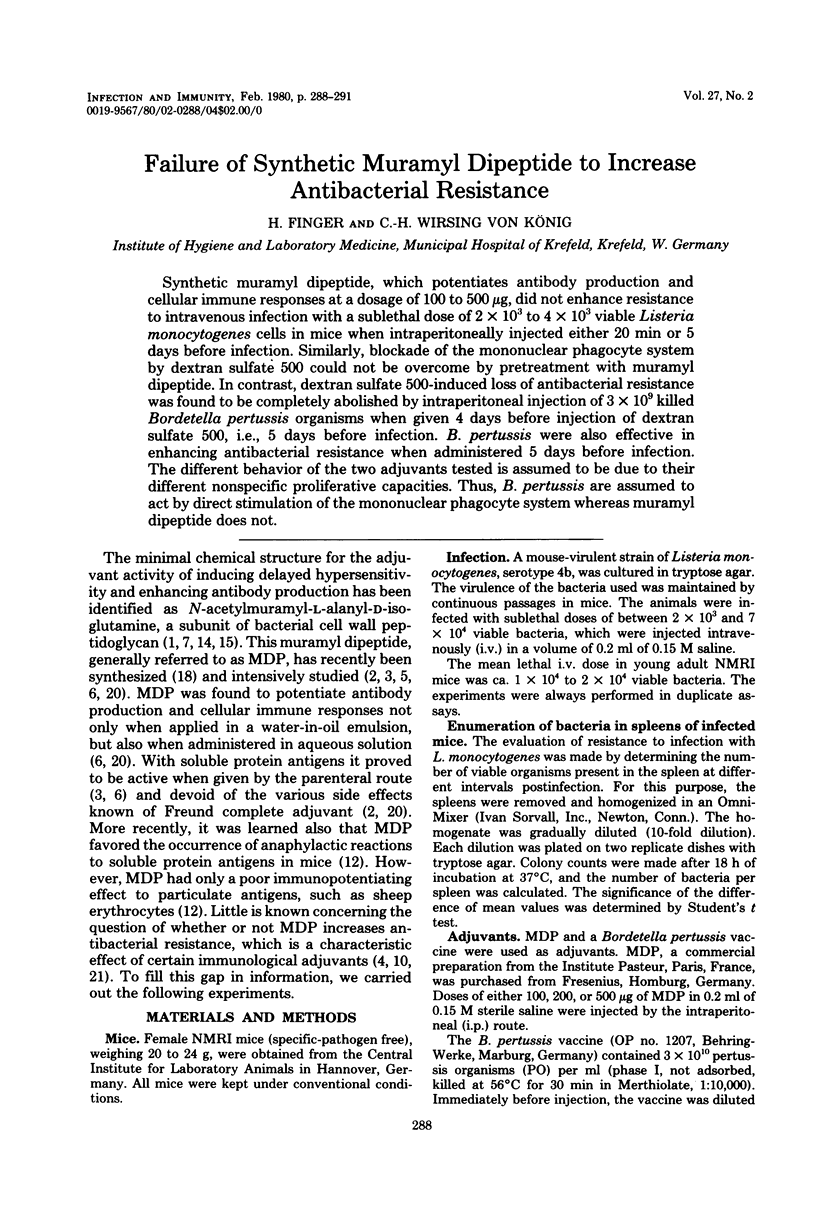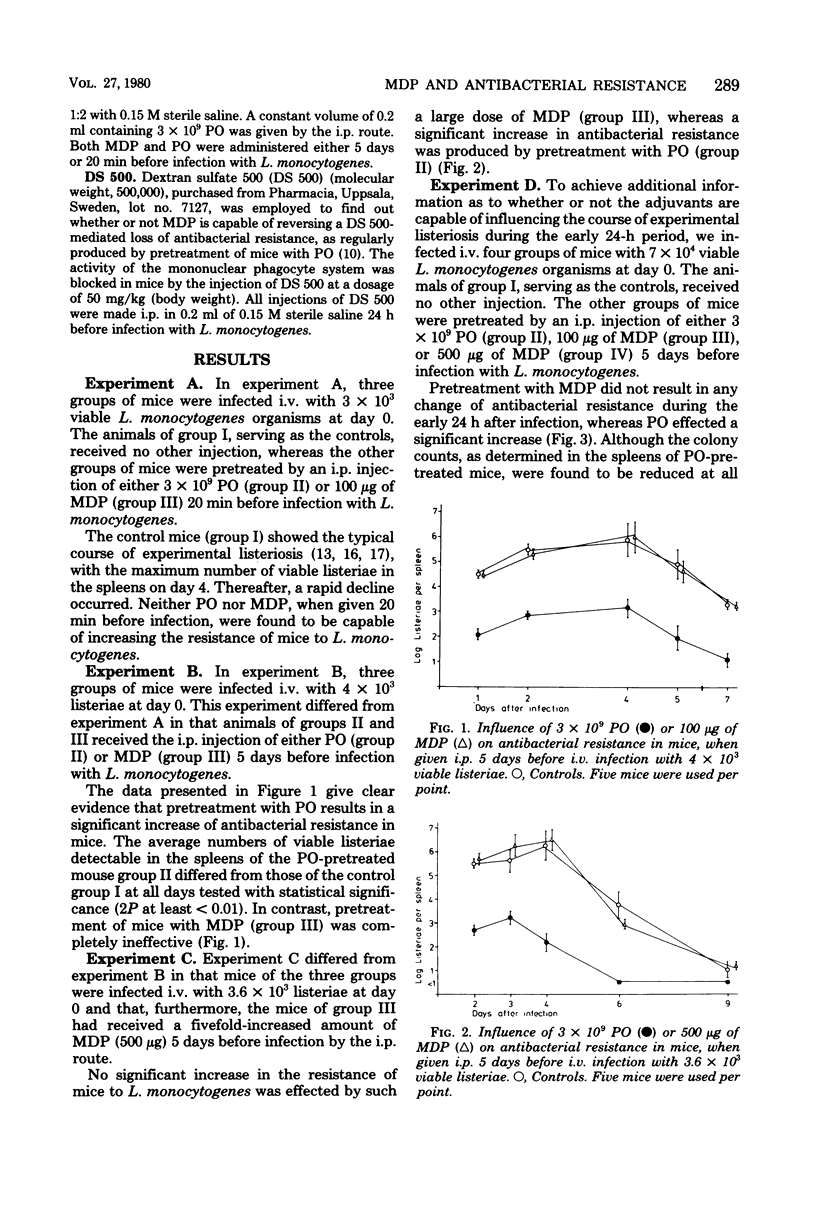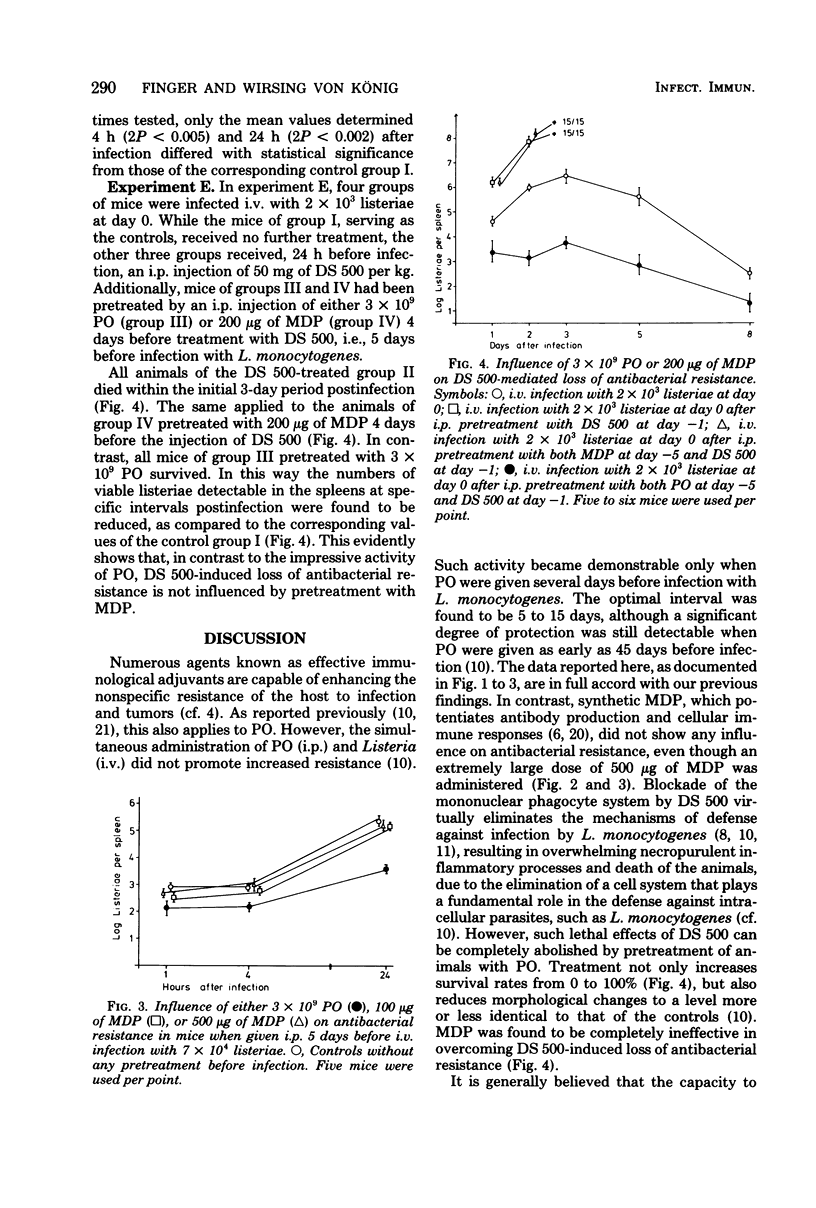Abstract
Synthetic muranyl dipeptide, which potentiates antibody production and cellular immune responses at a dosage of 100 to 500 micrograms, did not enhance resistance to intravenous infection with a sublethal dose of 2 X 10(3) to 4 X 10(3) viable Listeria monocytogenes cells in mice when intraperitoneally injected either 20 min or 5 days before infection. Similarly, blockade of the mononuclear phagocyte system by dextran sulfate 500 could not be overcome by pretreatment with muramyl dipeptide. In contrast, dextran sulfate 500-induced loss of antibacterial resistance was found to be completely abolished by intraperitoneal injection of 3 X 10(9) killed Bordetella pertussis organisms when given 4 days before injection of dextran sulfate 500, i.e., 5 days before infection. B. pertussis were also effective in enhancing antibacterial resistance when administered 5 days before infection. The different behavior of the two adjuvants tested is assumed to be due to their different nonspecific proliferative capacities. Thus, B. pertussis are assumed to act by direct stimulation of the mononuclear phagocyte system whereas muramyl dipeptide does not.
Full text
PDF



Selected References
These references are in PubMed. This may not be the complete list of references from this article.
- Adam A., Ellouz F., Ciorbaru R., Petit J. F., Lederer E. Peptidoglycan adjuvants: minimal structure required for activity. Z Immunitatsforsch Exp Klin Immunol. 1975 Jul;149(2-4):341–348. [PubMed] [Google Scholar]
- Audibert F., Chedid L., Lefrancier P., Choay J., Lederer E. Relationship between chemical structure and adjuvant activity of some synthetic analogues of N-acetyl-muramyl-L-alanyl-D-isoglutamine (MDP). Ann Immunol (Paris) 1977 Apr-Jun;128C(3):653–661. [PubMed] [Google Scholar]
- Audibert F., Chédid L., Lefrancier P., Choay J. Distinctive adjuvanticity of synthetic analogs of mycobacterial water-soluble components. Cell Immunol. 1976 Feb;21(2):243–249. doi: 10.1016/0008-8749(76)90053-8. [DOI] [PubMed] [Google Scholar]
- Block L. H., Georgopoulos A., Mayer P., Drews J. Nonspecific resistance to bacterial infections. Enhancement by ubiquinone-8. J Exp Med. 1978 Nov 1;148(5):1228–1240. doi: 10.1084/jem.148.5.1228. [DOI] [PMC free article] [PubMed] [Google Scholar]
- Chedid L., Audibert F., Lefrancier P., Choay J., Lederer E. Modulation of the immune response by a synthetic adjuvant and analogs. Proc Natl Acad Sci U S A. 1976 Jul;73(7):2472–2475. doi: 10.1073/pnas.73.7.2472. [DOI] [PMC free article] [PubMed] [Google Scholar]
- Ellouz F., Adam A., Ciorbaru R., Lederer E. Minimal structural requirements for adjuvant activity of bacterial peptidoglycan derivatives. Biochem Biophys Res Commun. 1974 Aug 19;59(4):1317–1325. doi: 10.1016/0006-291x(74)90458-6. [DOI] [PubMed] [Google Scholar]
- Emmerling P., Finger H., Hof H. Cell-mediated resistance to infection with Listeria monocytogenes in nude mice. Infect Immun. 1977 Feb;15(2):382–385. doi: 10.1128/iai.15.2.382-385.1977. [DOI] [PMC free article] [PubMed] [Google Scholar]
- Finger H., Heymer B., Wirsing C. H., Emmerling P., Hof H. Reversion of dextran sulfate-induced loss of antibacterial resistance by Bordetella pertussis. Infect Immun. 1978 Mar;19(3):950–960. doi: 10.1128/iai.19.3.950-960.1978. [DOI] [PMC free article] [PubMed] [Google Scholar]
- Hahn H. Effects of Dextran Sulfate 500 on Cell-Mediated Resistance to Infection with Listeria monocytogenes in Mice. Infect Immun. 1974 Nov;10(5):1105–1109. doi: 10.1128/iai.10.5.1105-1109.1974. [DOI] [PMC free article] [PubMed] [Google Scholar]
- Heymer B., Finger H., Wirsing C. H. Immunoadjuvant effects of the synthetic muramyl-dipeptide (MDP) N-acetylmuramyl-L-alanyl-D-isoglutamine. Z Immunitatsforsch Immunobiol. 1978 Oct;155(1):87–92. [PubMed] [Google Scholar]
- Heymer B., Hof H., Emmerling P., Finger H. Morphology and time course of experimental listeriosis in nude mice. Infect Immun. 1976 Sep;14(3):832–835. doi: 10.1128/iai.14.3.832-835.1976. [DOI] [PMC free article] [PubMed] [Google Scholar]
- Kotani S., Watanabe Y., Kinoshita F., Shimono T., Morisaki I. Immunoadjuvant activities of synthetic N-acetyl-muramyl-peptides or -amino acids. Biken J. 1975 Jun;18(2):105–111. [PubMed] [Google Scholar]
- Lane F. C., Unanue E. R. Requirement of thymus (T) lymphocytes for resistance to listeriosis. J Exp Med. 1972 May 1;135(5):1104–1112. doi: 10.1084/jem.135.5.1104. [DOI] [PMC free article] [PubMed] [Google Scholar]
- MACKANESS G. B. Cellular resistance to infection. J Exp Med. 1962 Sep 1;116:381–406. doi: 10.1084/jem.116.3.381. [DOI] [PMC free article] [PubMed] [Google Scholar]
- Merser C., Sinay P., Adam A. Total synthesis and adjuvant activity of bacterial peptidoglycan derivatives. Biochem Biophys Res Commun. 1975 Oct 27;66(4):1316–1322. doi: 10.1016/0006-291x(75)90503-3. [DOI] [PubMed] [Google Scholar]
- Specter S., Friedman H., Chedid L. Dissociation between the adjuvant vs mitogenic activity of a synthetic muramyl dipeptide for murine splenocytes. Proc Soc Exp Biol Med. 1977 Jul;155(3):349–352. doi: 10.3181/00379727-155-39804. [DOI] [PubMed] [Google Scholar]
- Tanaka A., Saito R., Sugiyama K., Morisaki I., Kotani S. Adjuvant activity of synthetic N-acetylmuramyl peptides in rats. Infect Immun. 1977 Jan;15(1):332–334. doi: 10.1128/iai.15.1.332-334.1977. [DOI] [PMC free article] [PubMed] [Google Scholar]
- Wirsing von König C. H., Finger H., Hof H., Emmerling P. Postnatal development of resistance against infection in an experimental model. Zentralbl Bakteriol Orig A. 1978 Dec;242(4):547–554. [PubMed] [Google Scholar]


